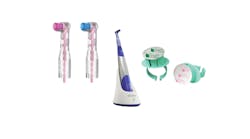Achieving a whiter, brighter smile is a particular focus for many patients. Some express interest in whitening products and seemingly prioritize their cosmetic goals above other more urgent conditions that may need treatment, such as gingivitis, periodontitis, and caries. Patients may also have hopes for cosmetic results that are beyond the scope of what whitening treatments can offer. Having honest conversations with patients about their whitening options can sometimes be difficult, especially when their expectations don’t align with their current oral health status.
As stated in the American Dental Hygienists’ Association (ADHA) Code of Ethics, dental hygienists are “devoted to the prevention of disease,” while striving to simultaneously “provide clients with the information necessary to make informed decisions about their oral health and encourage their full participation in treatment decisions and goals.”1 So, how do we as hygienists help prepare patients to be satisfied with the outcome of their teeth whitening treatments? The answer lies in having candid conversations with patients about their current oral health and how it relates to their cosmetic goals.
The candid conversation
Patient satisfaction is crucial in the long-term success of any business—including dental practices—because it has been shown to positively impact patient retention and clinical outcomes.2 Patients are more commonly satisfied when providers show interest, understanding, and willingness to openly discuss their problems and concerns.3 Carefully listening to patients and giving thoughtful, honest feedback builds rapport and encourages compliance to recommended treatments.4 Ultimately, this is because patients feel as if their dental providers treat them as people, not as patients.5
Good rapport with patients can open the door to detailed conversations that can motivate them to improve their oral health before diving into whitening treatment. It will also prepare patients for any adverse side effects or results that may vary from what they expected. This will help them feel more satisfied with their doctor and the recommended product or treatment.
Discuss current oral health
After assessing patients’ oral health, clinicians can better determine which whitening options would be most suitable to pursue. Depending on the health of the periodontal tissues and teeth, it may be necessary to explain to patients why their specific conditions ought to be addressed before they seek whitening treatment. This will help patients become more health literate.
Health literacy is defined as “the degree to which individuals have the capacity to obtain, process, and understand basic health information and services needed to make appropriate health decisions.”6 When oral health literacy is improved, patients also “improve adherence to medical instructions, self-management skills, and the overall treatment outcomes.”7 This proves beneficial for overall health and builds trust with clinicians, because patients “value dental professionals who tell them about existing preventive options, teach them about how to maintain the health of their mouth and teeth, and frequently support and reassure them during dental visits.”5 Not only do patients find this type of communication satisfying, but it also fosters loyalty to the dental practice and provides the groundwork for additional revenue.8
Cosmetic goals
Offering in-office whitening treatments and selling take-home whitening products to patients are excellent sources of additional revenue for dental practices. As patients of all ages express their desire for whiter smiles, it is important to have a discussion about their cosmetic goals and the specific whitening treatments that can help them meet those goals.
Here is a scenario that demonstrates why taking time to understand patients’ expectations is so important. A female patient in her early 50s says she’s interested in getting her teeth whitened. She has moderate recession on the facial surfaces of her anterior teeth, with severe sensitivity on her mandibular anteriors. Upon further questioning from the hygienist, the patient explains that she is highly self-conscious about the darkness of her exposed root surfaces. After a little more discussion, it becomes apparent to the hygienist that the patient is not aware that her exposed cementum is difficult to bleach and that a potential side effect from whitening treatments is major, temporary sensitivity. The hygienist kindly thanks the patient for sharing such a personal insecurity and validates that the sensitivity on her lower teeth must be very frustrating. The hygienist then explains that she would like to share some information that may be helpful as the patient considers moving forward with a bleaching treatment.
The hygienist simply shares some of the basic anatomy of the teeth by using a mirror to show the patient the areas where bleaching will be difficult. The patient has an opportunity to ask follow-up questions and inquire about the availability of other whitening products. Now that the patient is aware of the possible efficacy and side effects of treatment, she will be able to make an educated decision about how to proceed with the best treatment for her situation.
Taking time to discuss patients’ expectations and responding accordingly are crucial steps to helping them understand the results they can expect from various whitening treatments and be prepared for any discomfort or other side effects that may occur. Studies suggest that when patients’ expectations are unmet, their reactions can “range from disappointment to anger.”9 Taking the time to understand and manage patients’ expectations can improve their satisfaction with treatments, products, and the clinical staff. It will also help them to have more patience in the event of adverse side effects.9
Our priority
We should not lose sight of our responsibility to guide patients toward healthy behaviors, while encouraging them to be active participants in decisions regarding their oral health and cosmetic goals. When patients approach us for recommendations about whitening, let’s take time to listen carefully to their questions and concerns and use our knowledge to help them decide which whitening solutions will be best for them.
References
- ADHA Code of Ethics. American Dental Hygienists’ Association. June 2019. https://www.adha.org/resources-docs/ADHA_Code_of_Ethics.pdf
- Prakash B. Patient satisfaction. J Cutan Aesthet Surg. 2010;3(3):151-155. doi:10.4103/0974-2077.74491
- Ruiz-Moral R, de Torres LAP, Jaramillo-Martin I. The effect of patients’ met expectations on consultation outcomes. A study with family medicine residents. J Gen Intern Med. 2007;22(1):86-91. doi:10.1007/s11606-007-0113-8
- Kravitz RL, Cope DW, Bhrany V, Leake B. Internal medicine patients’ expectations for care during office visits. J Gen Intern Med. 1994;9(2):75-81. doi:10.1007/BF02600205
- Sbaraini A, Carter SM, Evans RW, Blinkhorn A. Experiences of dental care: what do patients value? BMC Health Serv Res. 2012;12:177. doi:10.1186/1472-6963-12-177
- Introduction. In: Institute of Medicine (US) Committee on Health Literacy; Nielsen-Bohlman L, Panzer AM, Kindig DA, eds. Health Literacy: A Prescription to End Confusion. National Academies Press; 2004:chap 1.
- Baskaradoss JK. Relationship between oral health literacy and oral health status. BMC Oral Health. 2018;18(1):172. doi:10.1186/s12903-018-0640-1
- McCarthy D, Bass J. New study: better dental patient relationships lead to $74,000 gain. DentistryIQ. June 4, 2019. https://www.dentistryiq.com/practice-management/patient-relationships/article/14034540/new-study-better-dental-patient-relationships-lead-to-74000-gain
- Lateef F. Patient expectations and the paradigm shift of care in emergency medicine. J Emerg Trauma Shock. 2011;4(2):163-167. doi:10.4103/0974-2700.82199







